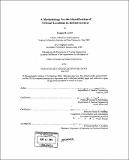| dc.contributor.advisor | George E. Apostolakis. | en_US |
| dc.contributor.author | Lemon, Douglas M. (Douglas Michael), 1967- | en_US |
| dc.contributor.other | Massachusetts Institute of Technology. Dept. of Nuclear Engineering. | en_US |
| dc.date.accessioned | 2005-06-02T18:29:55Z | |
| dc.date.available | 2005-06-02T18:29:55Z | |
| dc.date.copyright | 2004 | en_US |
| dc.date.issued | 2004 | en_US |
| dc.identifier.uri | http://hdl.handle.net/1721.1/17749 | |
| dc.description | Thesis (S.M.)--Massachusetts Institute of Technology, Dept. of Nuclear Engineering, 2004. | en_US |
| dc.description | Includes bibliographical references (leaves 72-76). | en_US |
| dc.description.abstract | The extreme importance of critical infrastructures to modem society is widely recognized. These infrastructures are complex, interdependent, and ubiquitous; they are sensitive to disruptions that can lead to cascading failures with serious consequences. Protecting the critical infrastructures from terrorism, human generated malevolent attack directed toward maximum social disruption, presents an enormous challenge. Recognizing that society cannot afford the costs associated with absolute protection, it is necessary to identify the critical locations in these infrastructures. By protecting the critical locations society achieves the greatest benefit for the protection investment. This project examines a screening methodology for the identification of critical locations in infrastructures. The framework models the infrastructures as interconnected digraphs and employs graph theory and reliability theory to identify the vulnerable points. The vulnerable points are screened for their susceptibility to a terrorist attack, and a prioritized list of critical locations is produced. The prioritization methodology is based on multi-attribute utility theory, and involves various disciplines including quantitative risk assessment and decision analysis. The methodology is illustrated through the presentation of a portion on the analysis conducted on the community of the Massachusetts Institute of Technology. | en_US |
| dc.description.statementofresponsibility | by Douglas M. Lemon. | en_US |
| dc.format.extent | 113 leaves | en_US |
| dc.format.extent | 4237228 bytes | |
| dc.format.extent | 4237035 bytes | |
| dc.format.mimetype | application/pdf | |
| dc.format.mimetype | application/pdf | |
| dc.language.iso | eng | en_US |
| dc.publisher | Massachusetts Institute of Technology | en_US |
| dc.rights | M.I.T. theses are protected by copyright. They may be viewed from this source for any purpose, but reproduction or distribution in any format is prohibited without written permission. See provided URL for inquiries about permission. | en_US |
| dc.rights.uri | http://dspace.mit.edu/handle/1721.1/7582 | |
| dc.subject | Nuclear Engineering. | en_US |
| dc.title | A methodology for the identification of critical locations in infrastructures | en_US |
| dc.type | Thesis | en_US |
| dc.description.degree | S.M. | en_US |
| dc.contributor.department | Massachusetts Institute of Technology. Department of Nuclear Engineering | en_US |
| dc.contributor.department | Massachusetts Institute of Technology. Department of Nuclear Science and Engineering | |
| dc.identifier.oclc | 56504116 | en_US |

